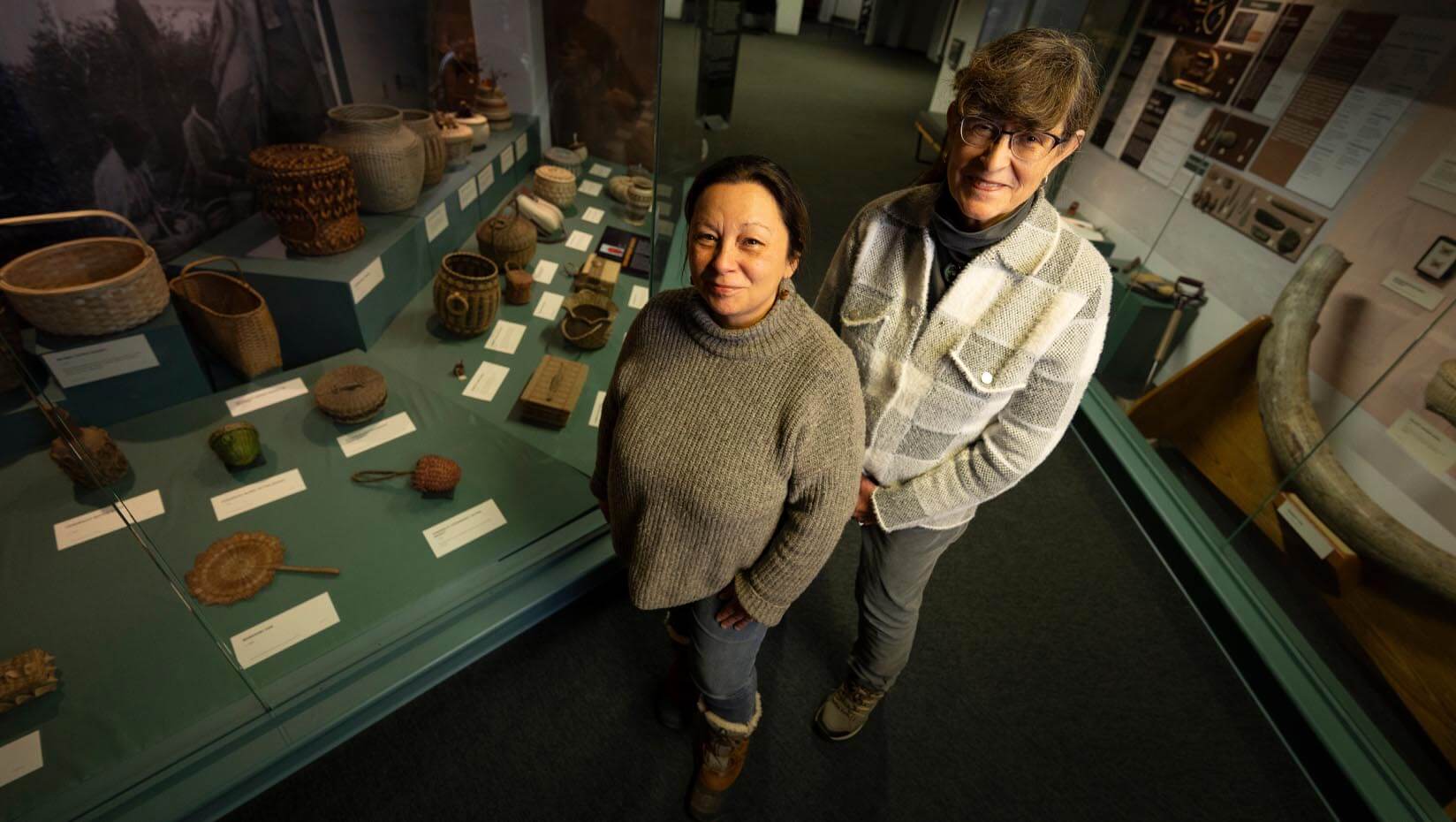
New Wabanaki basketry lexicon will give Indigenous communities a say in cultural representation
“This is special,” said Jennifer Neptune (Penobscot) as she peered through the glass pane of a display at the University of Maine Hudson Museum. “What’s unique about this one is the lace work around the outside edge. See how the ash is woven?” Her fingers moved in a weaving motion, an echo of the Wabanaki basket maker who came before her.
“It looks like lace.”
The placard below the piece reads “Wabanaki Fan, C. 1900.”
Currently on loan at the Hudson from the Penobscot Nation Museum, the fan is one of many ash and sweetgrass pieces that will be recorded in a new web-based lexicon — a vocabulary archive. The lexicon will contain indigenous-authored descriptive language for Wabanaki basketry and is funded by a $100,000 grant recently awarded to the Hudson and Penobscot Nation museums by the National Endowment for the Humanities.
The creation of the lexicon will take place over the next two years and will be hosted online on the Hudson Museum’s website when complete.
“Museums haven’t traditionally cataloged basketry collections in collaboration with the weavers who actually made the baskets,” said Gretchen Faulkner, director of the Hudson Museum. “This lexicon is a mechanism for creating a model for engagement with Indigenous communities. The project will provide a framework for other institutions to have standard terminology for describing different types of baskets, different types of weaves and ornamentation.” For the Hudson Museum, this project builds on nearly 30 years of collaboration with Wabanaki weavers.
The project will focus on the most common form of Wabanaki (Penobscot, Passamaquoddy, Maliseet and Mi’kmaq) cultural material in museums nationally: brown ash and sweetgrass basketry. Wabanaki basketry can be found in Maine and New England collecting institutions, as well as museums across the country. They are also central to the collections at Penobscot and Passamaquoddy tribal museums on Indian Island, Sipayik and Motahkomikuk.
The lexicon will contain photos of the items held in collections at the Hudson and Penobscot Nation museums accompanied by descriptions of the name for each style using terms from each Wabanaki community.
With leading museums closing displays exhibiting Native American objects in response to new Native American Graves Protection and Repatriation Act (NAGPRA) regulations, this project is a timely example of the evolving relationship between Native communities and museums. Currently, federal regulations are focused on repatriating human remains, associated and unassociated funerary objects and objects of cultural patrimony. The Hudson Museum has no human remains in its collection subject to NAGPRA and continues to consult with Native American communities on cultural material. Faulkner and Neptune view this lexicon as a crucial step in extending the curatorial model to communities systematically and structurally separated from their cultural heritage.
“These museums hold things that are really important to us and our communities,” Neptune said. “In the past, it hasn’t always been easy to access those collections to research or for makers to study their ancestors’ work to recreate or get inspiration from.”
Tools to make baskets, such as splint gauges, blocks and molds, are passed down within families. Gauges were used to divide splints into uniform widths for weavers and standards; blocks ensured that baskets were woven in consistent shapes and sizes. These tools were cherished family possessions and ensured the continuity of the tradition from one generation to the next. In addition to the tools used to make the baskets, each basket draws on generations of knowledge.
“Someone went out and got an ash tree in the woods and cut it down and pounded that ash out to get the splints to make the basket,” Neptune said. “Someone picked sweet grass in the summer by the salt marsh and picked by hand, one by one, the blades woven into a basket. There are a lot of ties to the materials that we create with, but also ties to places. Our people have places they go where their families have gone to pick sweet grass for generations upon generations. There are a lot of connections in any basket.”
Neptune was taught how to make baskets by traditional Penobscot basket makers and has mentored basket makers, including Sarah Sockbeson (Penobscot). Access to the pieces their ancestors made provides not only inspiration for these artists, but also sacred connection to the past.
“Sometimes you can’t tell from a photograph or from looking through the glass. Sometimes you have to get under things and count stitches and really look. You have to ask ‘how did they tie that off? What does it look like inside?’ to get that detail you need to be able to recreate something,” Neptune said.
For Neptune and her community, this project works toward reclaiming Wabanaki culture and history.
“It’s really important that people from the community get to access these things that their ancestors made,” she said. “These are not just objects, they have a living spirit that we have to interact with and attend to. Having those doors open up is a really good thing for everybody. For us, the community and the artists, and also for our museums.”
Contact: Shelby Hartin, shelby.hartin@maine.edu
